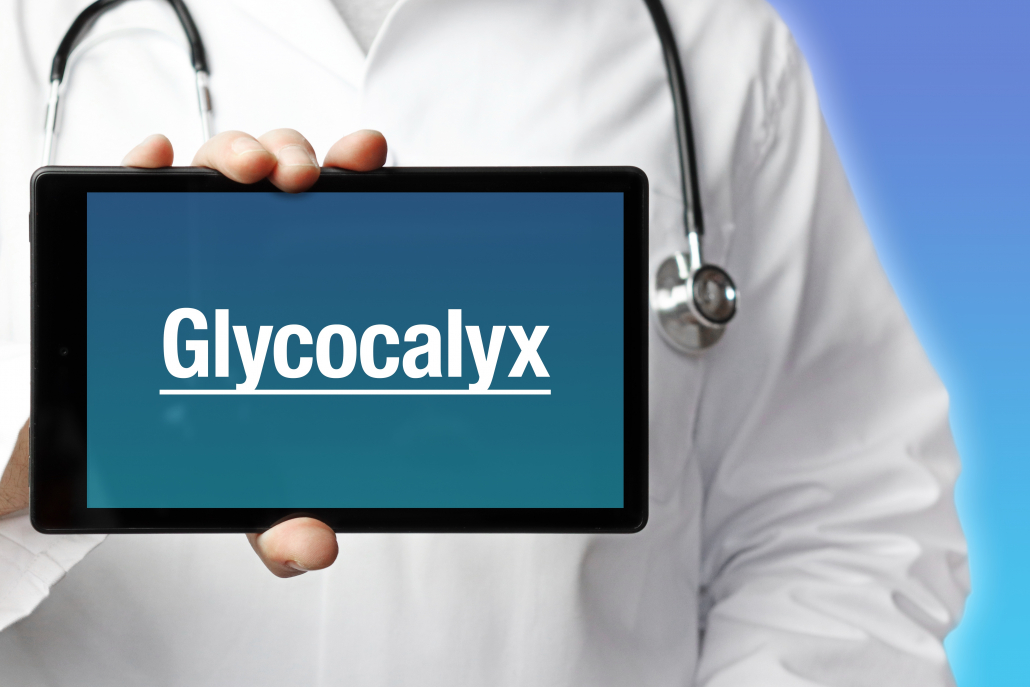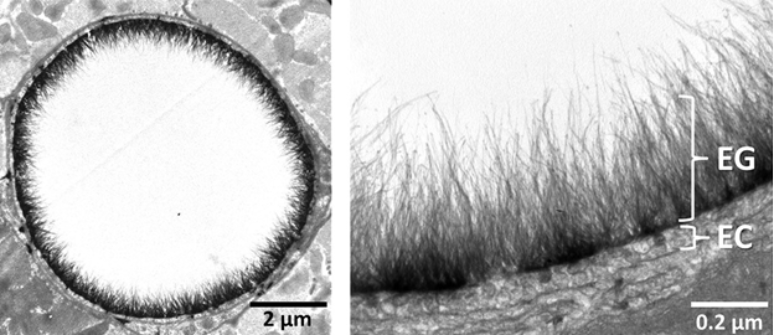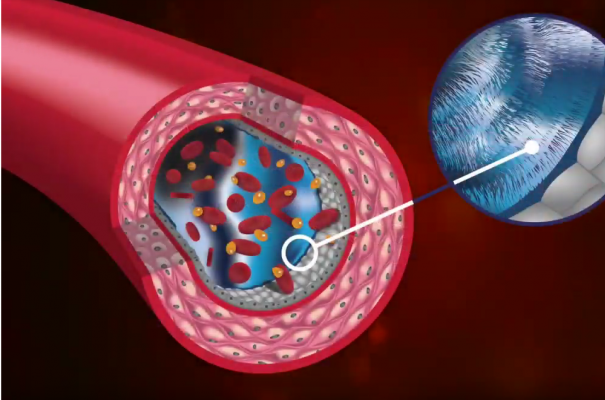We include products in articles we think are useful for our readers. If you buy products or services through links on our website, we may earn a small commission.
The Glycocalyx: Gatekeeper to Good Health?

Table of Contents
The key to your health and longevity may lie in something you’ve likely never heard of before: the glycocalyx. Crazy to think that something so few of us have heard of could have such a profound impact on our health, so let’s get into it.
In this article, we will examine what they glycocalyx is, recent research reveals about this microscopic structure, and how it may be the most overlooked, yet critical factor for good health.
For decades, the organization of the glycocalyx and its interplay with the cellular state have remained enigmatic. This changed in recent years. The latest research has shown that the glycocalyx is an organelle of vital significance, actively involved in and functionally relevant for various cellular processes, that can be directly targeted in therapeutic contexts.
In this article, we’ll introduce glycocalyx biology and describe the specific challenges glycocalyx research faces. We’ll discuss the role of the glycocalyx in light of several breakthroughs in glycocalyx research.
What is the Glycocalyx?
The glycocalyx is a dense layer of sugar molecules and the proteins and fats to which they attach that covers the outer membranes of all the cells in our bodies. The word glycocalyx literally means “sugar coat” (glykys = sweet, kalyx = husk), referring to its carbohydrate composition.
Under an electron microscope, the glycocalyx appears as a thin, fuzzy coating.

The glycocalyx is the hair-shaped substance seen above. Source: Online Library
While some functions of the glycocalyx have been none for decades, many of its important functions were only been discovered recently.
But the glycocalyx is responsible for many other critical functions:
- Regulating circulation to either increase or decrease bloodflow
- Protection: Cushions the plasma membrane of cells protecting against chemical injury.
- Regulates Inflammation: Glycocalyx coating on endothelial walls in blood vessels prevents leukocytes from binding.
- Fertility: Enables sperm to recognize and bind to eggs.
- Embryo development: Guides embryonic cells to destinations in the body.
- Immunity against infection: Enables the immune system to recognize and attack. foreign organisms.
- Defends against cancer: Changes to the glycocalyx of cancerous cells allow the immune system to recognize and destroy them.
- Transplant compatibility: Forms the basis for compatibility of tissue grafts, organ transplants, and blood transfusions.
- Cell adhesion: Binds cells together, keeping tissues from falling apart.
Why am I just now hearing about this?
The concept of the glycocalyx dates back to the 1940s, though its structure was impossible to observe at that time. It wasn’t until decades later that electron microscopes became powerful enough to capture the glycocalyx in action.
Making things more complex, the glycocalyx is difficult to stain and visualize, and vanishes when tissue samples are removed for study. In times of shock, the glycocalyx can actually dissipate, making it even harder to find.
The next several decades saw researchers striving to learn more about the glycocalyx and its functions. Some initially theorized that glycocalyx formed a matrix with sieving properties on capillary walls.
Since then, electron microscopy has captured the presence of glycocalyx covering the luminal side (inner side) of capillary walls, though its full function is still unknown.

The glycocalyx serves as a ‘cushion’ for red blood cells. Source: Lymphatic Network
The glycocalyx is composed primarily of carbohydrates, but that’s not all it contains. It also harbors signaling molecules like cytokines, chemokines, receptors, and growth factors, as well as various enzymes, including superoxide dismutase (SOD). All of these interactions are important for cell function, maintenance, and communication.
So now we know a little about what the glycocalyx is made of. But what does it do?
3 major ways your glycocalyx keeps you healthy
Think of the glycocalyx as a cellular gatekeeper. Just as a gatekeeper keeps intruders out, the glycocalyx guards and protects some of the most delicate cells in your body.
How? Partly by working with the immune system to protect capillaries from invaders. Damaged or toxic cells have often had their glycocalyx stripped away — a testament to its protective abilities.
The benefits of the glycocalyx can be divided into three major categories:
- Cardiovascular protection
- Hormonal regulation
- Increased blood flow
Cardiovascular protection
The glycocalyx protects the capillaries that nourish every cell in our bodies and make up 99% of the circulatory system.
Capillaries are tiny blood vessels that deliver nutrients and remove waste from hard-to-reach places. Capillaries aren’t just hollow pipes that allow blood to flow through them — they’re living, nutrient-exchanging structures. The average adult’s body contains nearly 100,000 miles of them!
With every heartbeat, capillaries transport vital nutrients and oxygen to each cell — and the glycocalyx’s presence facilitates it all.
Here are several more ways this structure protects cardiovascular function:
- Its anti-adhesive properties prevent platelets from coagulating and leukocytes from sticking to vascular walls. Prevention of leukocyte adhesion is especially important because leukocytes move around from place to place as needed. The glycocalyx basically adds another layer to this very important immune function.
- It’s involved in extracellular signaling (i.e. cell-to-cell communication), which may impair cancer cell growth throughout the cardiovascular system.
Hormonal regulation
The glycocalyx is a significant mediator of nitric oxide (NO) production from endothelial cells.
The glycocalyx seems to subject endothelial cells to just enough pressure to trigger NO production. NO, in turn, “‘informs’ the muscle cells around a blood vessel to contract or relax thus constricting or widening the vessel, so as to regulate the flow of blood.”
Nitric oxide is also involved in regulating the flow of nutrients and oxygen. Without a healthy glycocalyx, this regulation is compromised.
The glycocalyx’s effect on nitric oxide means it has a downstream effect on other hormones, including carbon dioxide, which works with oxygen to optimize your body’s oxygenation levels.
Increased blood flow
The glycocalyx can also increase blood flow, partially thanks to its ability to mediate nitric oxide. There are other pro-circulation benefits, too:
- Allows the body to engage more of its capillaries, delivering more nutrients to and/or removing waste from organs as needed.
- Protects the endothelial cells from direct pressure caused by blood flow, helping to regulate their shape.
- Regulates the permeability of blood vessels, preventing an increased influx of proteins, water, and other blood-borne elements like low-density lipoprotein (“bad” cholesterol).
Why the glycocalyx health is so important
Simply put, the glycocalyx is essential for protecting the health of the circulatory system.
Circulatory health, in turn, has many downstream benefits.
There’s a potential problem, though: the glycocalyx is delicate. And while it degrades naturally over time or during certain stressful events, this process can be exacerbated by other factors, including:
- High-carbohydrate diet
- Lack of exercise
- Genetic factors
- Chronic inflammation
- High blood pressure
- Smoking
- Trauma
- ARDS
- COVID-19
Damage to the glycocalyx can also cause shedding of the antioxidant enzyme SOD, which converts reactive oxygen species (ROS) to hydrogen peroxide. Without SOD, the balance of the endothelium is shifted to a pro-oxidant, hyper-inflammatory state.
Furthermore, damage to the glycocalyx can lead to further trauma to the vascular endothelium, leading to leaky capillaries that may lose function and/or die off.
What diseases have been linked to glycocalyx damage?
Without the vital nutrients and oxygen supplied by capillaries, tissues and vital organs starve. Impaired tissue perfusion has been repeatedly shown to be the root cause of major diseases and health complications, including but not limited to:
- Sepsis
- Diabetes (type 1 and type 2)
- Heart failure
- Lung disease
- Kidney disease
- Stroke
- Dementia
- Early-onset preeclampsia
- Inflammatory disorders
- Cancer progression
Unfortunately, medical researchers estimate that a large percentage of the world’s population is affected by glycocalyx breakdown.
Atherosclerosis
As we discussed earlier, inflammation can trigger the endothelial glycocalyx to dissipate, which only promotes further inflammation.
This dissipation can allow ‘bad’ cholesterol to enter the bloodstream, become oxidized, and form a lipid layer. This further promotes the shedding of the glycocalyx. Eventually, leukocytes and other types of white blood cells called monocytes and lymphocytes begin to infiltrate the intima or innermost coating of the endothelium.
Once monocytes enter the intima, they become macrophages, which consume oxidized LDL cholesterol to form a fibrous cap, thereby stabilizing the plaque. If this fibrous cap is disturbed, it can lead to cardiovascular events like heart attacks and strokes.
The steps described above are highly simplified versions of the complex process that is atherosclerosis. However, it’s clear that the glycocalyx plays a crucial role in resisting the build-up of plaques and keeping blood vessels healthy.
Why a high-carb diet damages the glycocalyx
Eating a diet high in carbohydrates can spell trouble by causing spikes in blood sugar levels.
In one research study, only 6 hours of exposure to high blood sugar reduced glycocalyx volume by a whopping 50%. The research team credited high blood sugar’s damaging effects to increased oxidation and inflammation. This was confirmed when they infused glucose with a strong antioxidant, and the glycocalyx volume remained unchanged.
Considering that glycocalyx damage is thought to be the “first step” towards atherosclerotic problems of all kinds, the speed with which high glucose can reduce glycocalyx volume is eye-opening.
High blood sugar may also cause the mitochondria (the energy factories in each cell) to overproduce too many free radicals, including reactive oxygen species (ROS). ROS are key signaling molecules that regulate the natural inflammatory responses in our bodies.
In a healthy system, antioxidants quench ROS when they are no longer necessary, but too many and chronically high ROS can lead to oxidative stress, DNA damage, and eventually chronic diseases like cancer, and heart disease, among many others.
In short, a high-carb diet can devastate the glycocalyx — and your health.
How to eat for your glycocalyx
Given its significance, the glycocalyx may serve as a promising target in the treatment of chronic diseases. Researchers have been looking into ways to regenerate and/or protect the glycocalyx.
In the absence of any new breakthroughs, however, we know of one surefire way to protect your glycocalyx from breakdown: eat a low-carb, high-fat diet, ideally a carnivore diet.
When carbohydrate intake is reduced, blood sugar levels will stabilize, preventing damage to the glycocalyx and its sensitive glycolipids and glycoproteins.
Certain supplements may also help maintain a healthy glycocalyx. These include:
- Hyaluronic acid
- N-acetyl cysteine (NAC)
- Chondroitin sulfate
- Nitric oxide boosters
- Activated protein C
- Hydrocortisone
- Progesterone
While these supplements may work, they shouldn’t be used as a bandaid solution. Consider taking the holistic route — eating a nourishing, anti-inflammatory diet — first. And always consult a healthcare professional before making drastic changes.
The Takeaway
Scientists are continuing to learn just how important the glycocalyx is for the cardiovascular system and for general health.
The more they learn, the clearer the dangers of regular sugar and starch consumption become. As we’ve seen, hyperglycemia can prematurely degrade the glycocalyx covering of capillaries. This simple-yet-serious occurrence may very well explain the high rates of cardiovascular diseases seen in our country.
Thankfully, protecting yourself is as easy as protecting your glycocalyx. You can get started by reducing your consumption of processed carbohydrates and focusing on healthy fats and proteins. Stress-reducing practices like walking, yoga, mindful eating, and meditation may also help.
Take care of your glycocalyx, and it’ll take care of you.





















